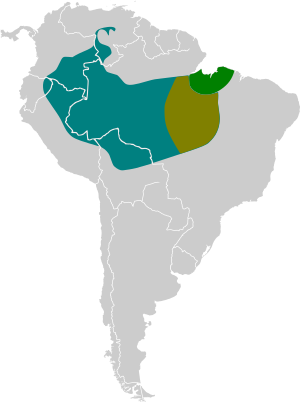Olive oropendola facts for kids
Quick facts for kids Olive oropendola |
|
|---|---|
 |
|
| Conservation status | |
| Scientific classification | |
| Genus: |
Psarocolius
|
| Species: |
bifasciatus
|
 |
|
The olive oropendola (Psarocolius bifasciatus) is a really big and cool bird found in the Amazon Basin in South America. It's one of the largest songbirds in the world! These birds are part of the icterid family, which includes orioles and blackbirds. You might hear its name, "olive oropendola," but sometimes its head and chest are black, not olive!
Contents
What Does the Olive Oropendola Look Like?
The olive oropendola is a very striking bird. Males and females look quite different in size. The male is about 52 centimeters (21 inches) long. That's almost as long as your arm! He weighs around 550 grams (1.2 pounds). The female is smaller, about 41 centimeters (16 inches) long. She weighs about 260 grams (9.2 ounces).
Most of this large bird's back, wings, and belly are brown. Its outer tail feathers are bright yellow, so its tail looks all yellow from below. It has pink skin on its face and brown eyes. Its bill is black with a bright orange tip.
You might get it mixed up with the green oropendola. But the green oropendola has an olive back and different wing colors. It also has less bare skin on its face and blue eyes.
Behavior and Life
Where Do They Live?
The olive oropendola is a "canopy bird." This means it spends most of its time high up in the tops of tall trees. You'll often see them flying high above the forest.
How Do They Act?
Compared to other birds in its family, the olive oropendola is a bit of a loner. You'll most often see them by themselves or in pairs. They don't draw as much attention as their relatives, even though they are bigger. Sometimes, small groups might gather. They might even hang out with other types of oropendolas.
Nests and Reproduction
When it's time to have babies, these birds form small groups. Their breeding colonies usually have fewer than five birds. They build amazing nests! The nest is like a long, hanging woven ball. It's made from fibers and vines. These nests can be very long, from 60 to 180 centimeters (2 to 6 feet) long. They hang high up in a tree, keeping the young safe. Scientists are still learning a lot about how these birds raise their families.
What Do They Eat?
The olive oropendola eats many different things. This means they are "omnivores." They might eat small animals like frogs and lizards. They also enjoy large insects, sweet nectar from flowers, and tasty fruits. They often fly long distances through the forest to find food. They only stay in one spot when they are near their nesting colony.
Their Unique Song
The song of the olive oropendola is very special. It sounds like a bubbly, gurgling sound. It's like "stek-ek-ek-ek-eh-eh-eh-o'o 'GLOOP!'" The male bird makes this sound when he leans forward on a branch. He also rustles his wings over his back while singing. When they are flying or looking for food, they make nasal calls like "raap" and "whrup."
Gallery
See also
 In Spanish: Cacique de Pará para niños
In Spanish: Cacique de Pará para niños




